Flying iPhones, Break-Dancing Knights, and $10,000 Worth of Corn: How ‘Fallout’ Came To Life on TV
- Oops!Something went wrong.Please try again later.
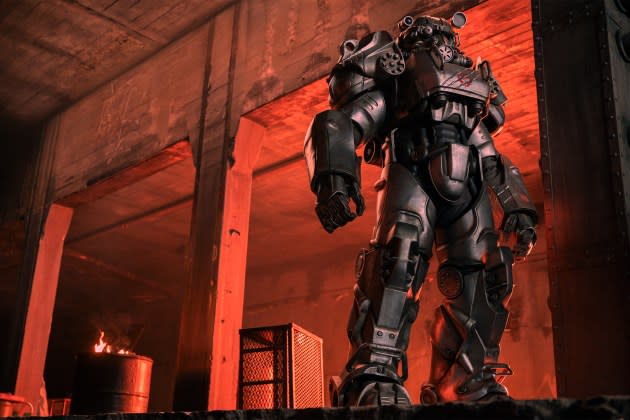
It’s a frigid February day on the Brooklyn waterfront, and the world is ending. A dusting of snow powders the makeshift walkway through the rubble stacked high. Underneath, shanties made of scrap flex and creak with each step. Directly ahead, the disembodied nose of a commercial airliner dangles from the roof of a junkyard saloon. All over town, bullet casings pepper the dirt among the ruins of whatever life was once here. This is a place of violence.
More from Rolling Stone
‘Fallout’: How to Succeed in the Postapocalypse Without Really Trying
Is ‘Fallout’ the Next ‘The Last of Us?’ Inside the Dystopian TV Series
Except this is all just an elaborate set. Tucked within the Brooklyn Navy Yard is a massive studio lot where filming has taken place for the live-action adaptation of the Fallout video game series. During one of the final days of filming, Rolling Stone has been invited to the show’s soundstages to speak with many of the creative minds working to bring the world of one of gaming’s weirdest properties to television.
Set in 2296, over 200 years after nuclear holocaust eradicated most life in the northern hemisphere, Fallout is a post-apocalyptic tale with a twist: What if American exceptionalism thrived beyond the Eisenhower era, bypassing the Watergate years and any sense of cultural self-reflection, right up until the bombs dropped? In the irradiated wastes of a once idyllic Fifties-era society, life not only exists but thrives. Since the original game launched in 1997, the Fallout series has told a deeply strange story that satirizes all aspects of Americana, from unhinged jingoism and quasi-religious militarism to the shallow vanity of commercialist obsession, all wrapped in a comedic atompunk veneer. Now, after four mainline entries and numerous spin-offs, Fallout is making the leap to television to continue that story.
The brainchild of Westworld co-creator Jonathan Nolan and executive producers/showrunners Geneva Robertson-Dworet and Graham Wagner, Prime Video’s Fallout (premiering April 10) aims to be the next big video game to make the transition to prestige TV. Nolan and co. are determined to break new ground by both faithfully recreating practically every aspect of the game’s world and using its visual language and themes to tell an entirely new story, one canonically set within the series.
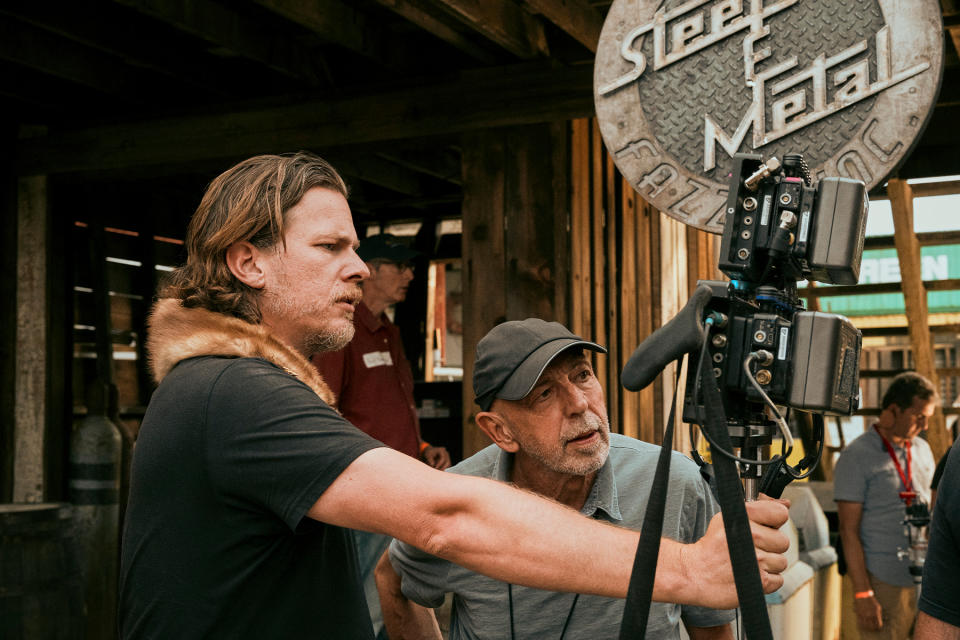
Unlike the game, which follows a single, player-controlled character, the series will center around three different leads. There’s Lucy (Ella Purnell), a naive young woman who grew up in an underground vault and is forced into the wasteland for the first time in search of her missing father. Along the way, she’ll encounter Maximus (Aaron Moten), a member of the militaristic Brotherhood of Steel, an organization whose role varies game to game, but here serves as a violent force maintaining order. Lastly, there’s The Ghoul (Walton Goggins), a disfigured gunslinger with mysterious ties to the world that was before the wasteland.
By choosing to create their own narrative rather than adapt an existing one, the writers were immediately tasked with worldbuilding. Choosing Los Angeles as their setting allowed them to play in a familiar space, as the first two games in the series are set in California, but gave the writers the freedom to explore a region that would be new to more recent fans who may have played the modern games set in D.C., Boston, or Vegas. With the story cracked, the real challenge would be how deeply they’d go to create a tangible sense of reality for this unreal world.
The day of the set visit includes seeing several practical sets erected on the Steiner Studios backlot, all of which are enormous. The first location was Vault 33, the subterranean home of one of Lucy. Beginning with a vault is fitting, as fans of the games know, as pretty much every mainline entry in the series also begins within one of these underground. Functioning as fallout shelters for those with enough money or clout to survive the bombings of 2077, they serve as the entry point for players into the RPG world.
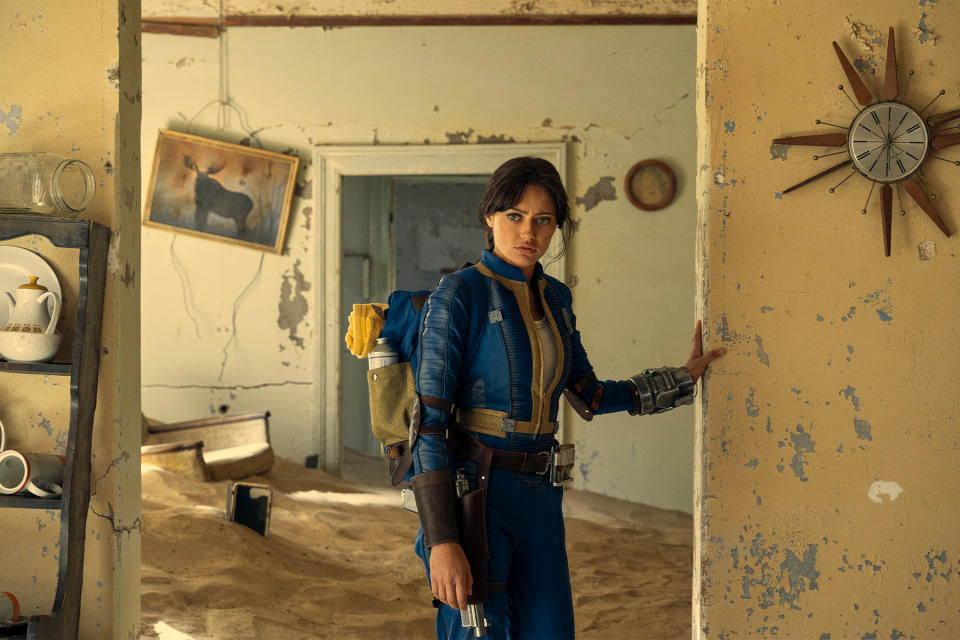
But no two vaults are alike, and this one is particularly unique. As I’m led through the thick black curtains behind the studio flats, I can hear rustling around the bend. Inside, there’s an entire cornfield housed in a massive atrium, surrounded by blue screen. Howard Cummings, the show’s production designer, explains that the screens will show a deep blue sky, extending the otherwise claustrophobic space of an underground shelter to resemble an open field. And while the illusionary sky is fake, the corn is very real. “This is $10,000 worth of corn,” he says.
Moving on from the atrium, the rest of the vault very much resembles the look and feel of the game. The aluminum-clad corridors lead to individual rooms, with guillotine doors — many of which actually work — including vault-dweller homes with a retro-futuristic aesthetic, a med bay, and a room that previously served as a makeshift prison cell.
Continuing through the vault, it’s difficult not to feel an uncanny sense of déjà vu. The modern Fallout games are first-person RPGs, and players will scour every nook and cranny, looting drawers and lockers for survival, but being in the vault is disorienting as every detail — down to the glass, window lining, and rivets — is game accurate. As someone who’s played hundreds of hours, it feels like I should be able to work my own body with a controller.
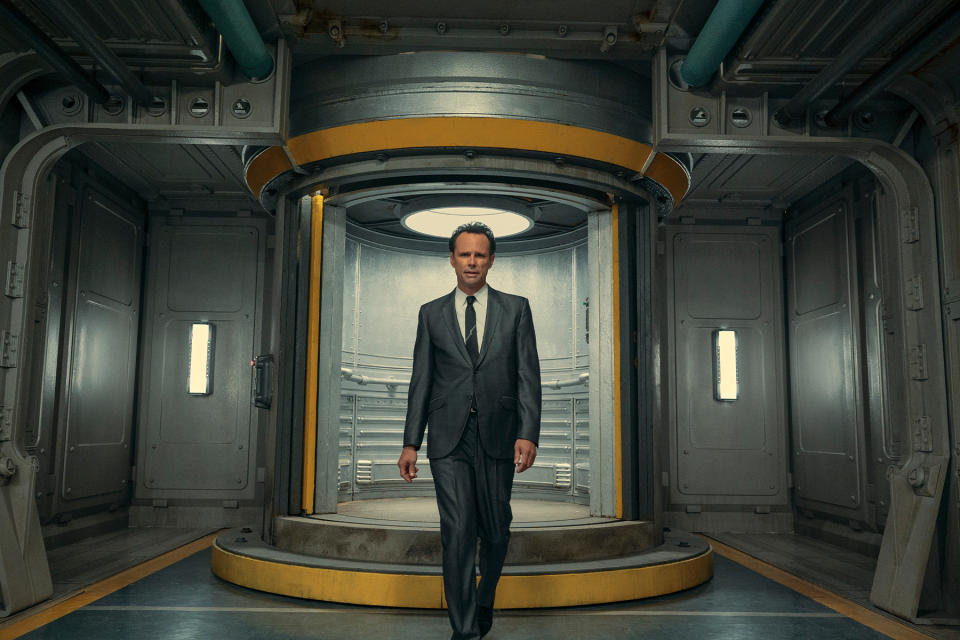
It’s thanks to Cummings, who clutches his inches-thick production bible filled with concept art, that the experience is so uncanny. Working directly with Bethesda, who has developed the games since 2008’s Fallout 3, he was able to not just emulate their design but recreate it nearly 1:1. To do so, he was given access to a full suite of 3D models and renderings, primarily from the most recent game, Fallout 76, to use as building blocks.
“In the game, if you’re building your vault, they give you a kit and it’s 12’x12’ cube, which includes walls, floors, and ceiling,” he says, insisting that if players were to go into the game and construct their own vault, they could faithfully recreate what he’s built here for the show. “I took in the kit and broke them down, then we made them all. All these bolts – I had three 3D printers in my office and a production assistant, then we cook them all day.”
While the focus on authentically recreating even the most infinitesimal details of vault life was essential for the team, it’s the world beyond that vault where players — and now viewers — will truly get an understanding of Fallout. And it’s outside the soundstage where that sense of scope is realized.
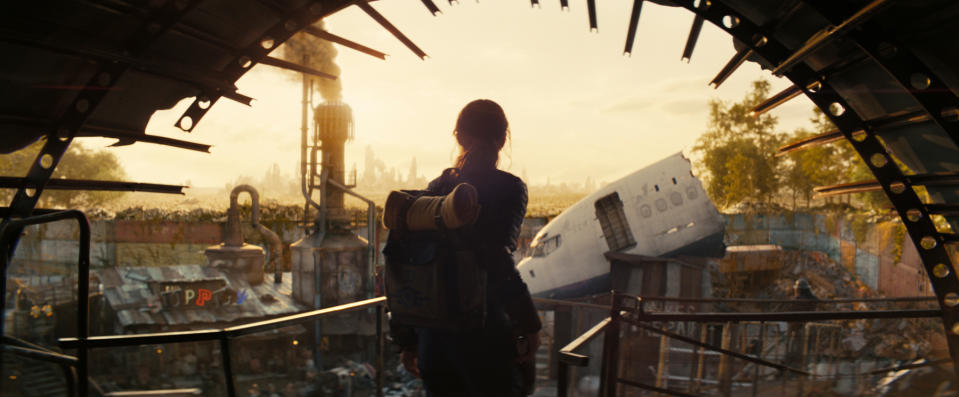
Further into the industrial complex of the navy yard, past swaths of tall grass and a derelict bus, there’s a towering cylinder composed of shipping containers. Several stories high, it resembles a colosseum of scrap. But the structure itself isn’t the sight, it merely serves to obfuscate what’s inside.
This is Filly, one of the central locations created for the show, and one of the first stops for characters like Lucy when she makes her way outside her vault for the first time. With a steep climb that induces jelly legs, ascending to the top of the container yard leads to around to the entrance, a piece of fuselage that unveils the town itself.
Equal parts frontier town and junkyard (hence the name Filly, like landfill), the set houses an almost overwhelming amount to see. Cummings designed it as a combination of Fallout 3’s Megaton and Fallout 4’s Diamond City, it’s a center of commerce that shows how society evolved in this new world. It bears all the hallmarks of the game’s post-apocalyptic take on the West: a supply shop fallen into disrepair, an old-timey saloon with a neon Nuka-Cola billboard off to the side, and even a barber/dentist sign that reads, “We buy teeth.”
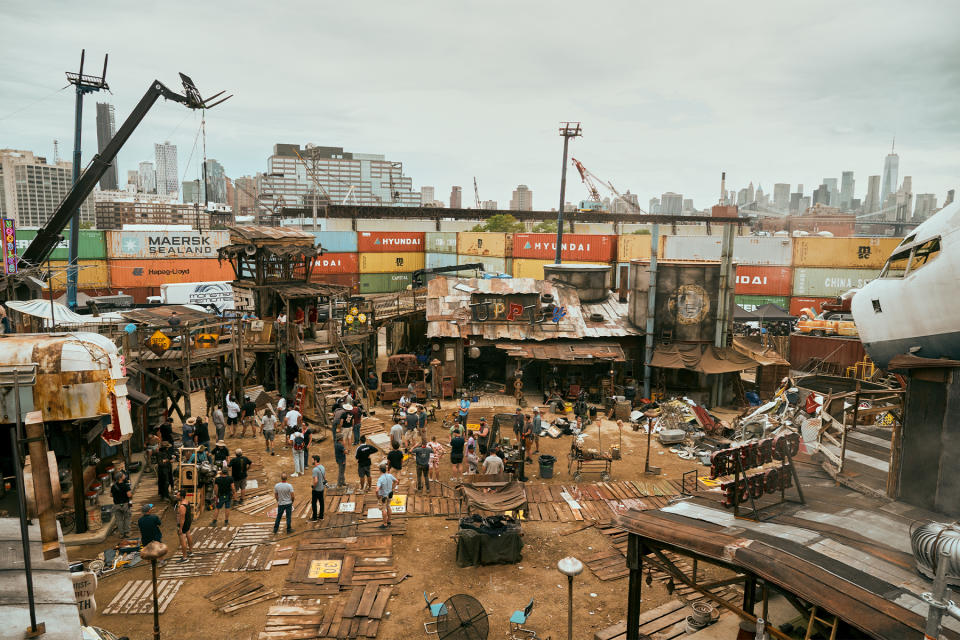
Cummings walks me through each of the structures, occasionally pulling up pages from his bible to show how closely the final product resembles the early stages. Much like the vault, every detail is handcrafted, but unlike the cold corridors of 33, Filly feels like Disneyland from hell, and makes the gruesome spaghetti western imagery of Westworld feel quaint in comparison.
The dusty ground dotted with bullet casings and bloodied steel, it’s clear a huge battle had occurred. Inside the supply shop, everything is in shambles and not just because it was the scene of a wholesale massacre, but because the production crew is actually disassembling the set.
“None of this will be here tomorrow,” Cummings says.
The set of Filly is the kind of off-kilter take on a location that might be familiar to audiences — it’s Deadwood by way of your local dump. Here, scoundrels, cowboys, and mutants alike will meet as the story of Fallout unfurls its American odyssey through the eyes of its multiple protagonists. One character in particular embodies all three: Walton Goggins’ gunslinger, the Ghoul.
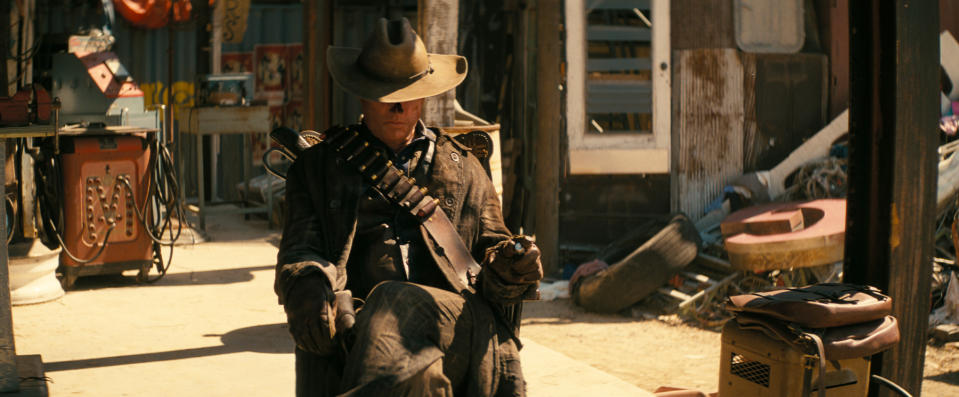
“Walking onto the set of Filly for the first time was so humbling,” Goggins tells Rolling Stone in a later interview. “I didn’t peek before we began filming when offered a chance. I wanted to wait until my first day working. So, when I walked onto set, it blew my mind.”
No stranger to playing morally dubious cowboy-types in Justified and The Hateful Eight, Goggins had some expectations, but what he saw on Fallout was a radical departure.
“I’ve spent my fair share walking down the main streets of western sets, but this was something entirely different,” he says. “It was a retro futuristic cowboy punk Dodge City filled alive with 150 extras that looked like they walked off the set of Mad Max. It had a gat-damn nose of an airplane in it! It was electric.”
But to embody the scope of the world they created, the production didn’t just rely on soundstages in New York. Much of the series was filmed in remote locations, including the Skeleton Coast of Namibia, which Nolan describes as “[Looking] almost exactly like Santa Monica, minus the mountains.”
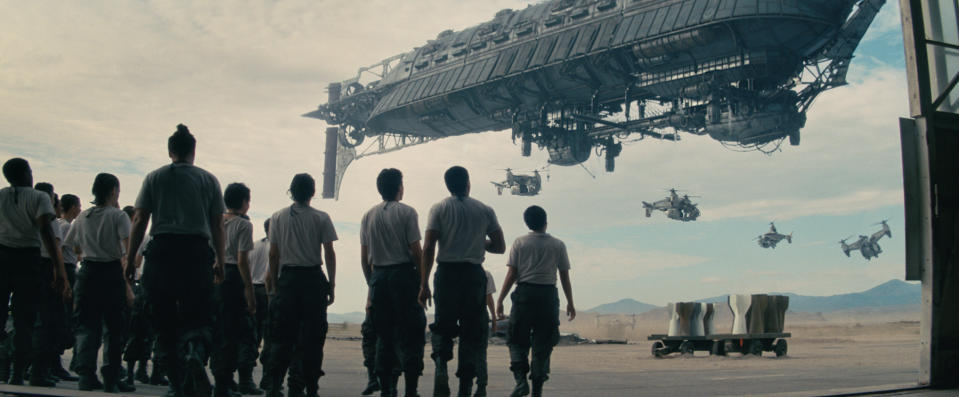
Utah, too, served as a major shooting location for the base of the Brotherhood of Steel. Aaron Moten, who plays Maximus, spent much of his time there filming at the Brotherhood’s HQ, which blended shades of the elaborate set design seen back at the soundstages in Brooklyn with the expansive semi-arid backdrop of the Mountain West.
“I was super anxious about getting out to Utah to shoot the Brotherhood base,” Moten says. “And, arriving there, the first thing I did was after a stunt rehearsal, I rushed over to the barracks, I just wanted to see my bed! I wanted to see where I live. Looking at all the detail in this bunker that they had put together. The camera catches glimpses of these things, but you know, these magazines are real magazines, everything is full and everything is ready to be used.”
Moten’s exuberance about the Brotherhood base is understandable once you lay eyes on the iconography recreated for the series. It’s not just the set design that had to be faithfully imbued with the tone of the games, but all of the individual costumes and props.
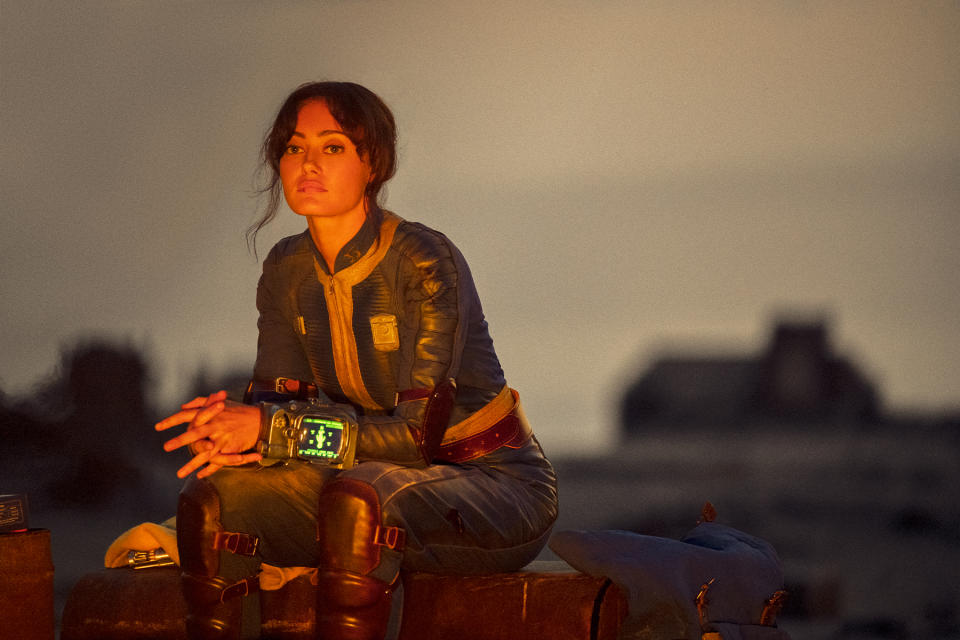
Walking through the prop cage with Cummings, fear strikes at the sight of the gaping maw belonging to a gargantuan amphibian creature, gums lined with razor sharp teeth. Over 10 feet long, this is one of the ugliest creatures fans will recognize from Fallout 4, the Gulper. In the series, Gulpers will be one of the many monstrosities brought to life through a mix of practical and digital effects, but the prop masters on site are very clear that this particular Gulper was created with a mouth that just so happens to be big enough for a full human to fit in — an invitation I politely decline.
The cage itself looks equal parts armory and Halloween pop-up shop with wall-to-wall racks of severed limbs and bowls of bloody guts. Shelves house several of the games’ most recognizable weapons from pistols to rifles, and of course a minigun. But the main event is off in the distance, with a massive suit of power armor hanging from chains. This is the T-60 (“with the tempered lining”) belonging to the knights of the Brotherhood of Steel.
There’s many versions of the armor built for the series, as well as some borrowed from skilled cosplayers initially considered for background use, but deemed too impractical compared to something custom made for the production. The actual ones were designed by Legacy, the company that produced Tony Stark’s suits for Iron Man, the suit’s initial prototype was among the first props produced for the series, taking roughly 18 to 20 weeks to fabricate even a “decent” model, as Cummings puts it. But impressive as they are, you might wonder how many of these suits are realistically used in action rather than replaced by CGI. Turns out, it’s all of them.
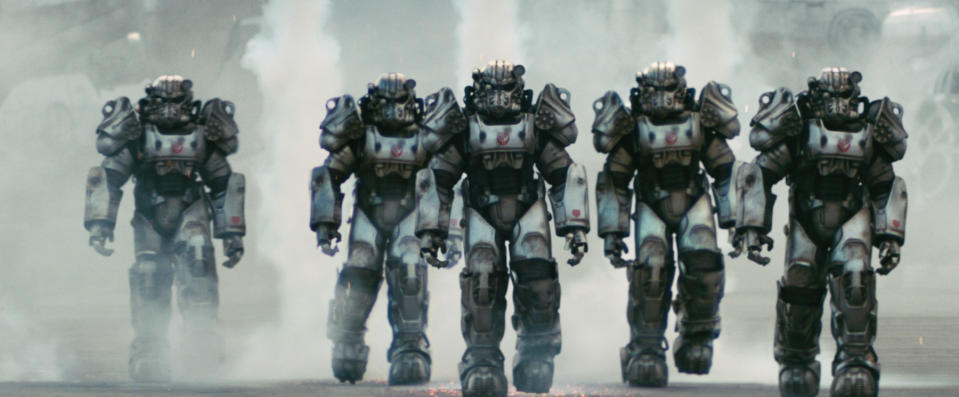
According to the props team, multiple full-body suits were created specifically for lead stunt performer Adam Shippey to wear throughout filming. Each weighs upward of 150 lbs when fully assembled, and makes the actor stand over 7 feet tall. No small feat for walking around looking tough, but Shippey himself had gotten so comfortable in the suit that he claims he could actually break dance. (I’m still waiting for that footage.)
Amid the guts and guns lies one of the most beloved pieces of Fallout lore: the arm-mounted personal computer, Pip-Boy. The show’s version of the Pip-Boy is based on Fallout 4 but had to be slightly scaled down to accommodate the actual dimensions of a human arm. The ones here are missing something, however: a screen.
For the show, the Pip-Boys are frames that house iPhones, built with a custom app that allow the actors to interact with the computer in real time. That wasn’t always an easy process, however, according to Purnell.
“I have a tendency to break things,” she jokes. “This Pip-Boy is an iPhone sideways in this sort of magnetic contraption and it clasps up. But when you talk with your hands, as some of us do, then maybe the Pip-Boy might go flying off into the other side of the corner. I went through a couple of iPhones, I’ll put it that way.”
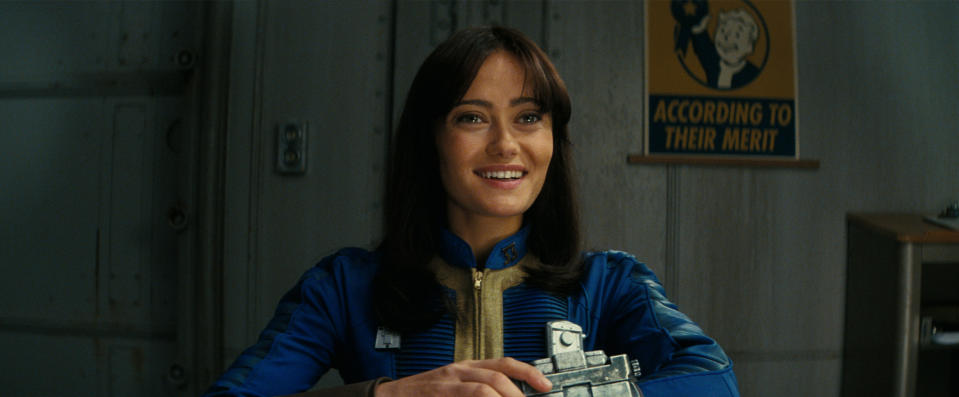
The practical application of an iPhone wedged in a prop bracelet is the kind of filmmaking magic that’s needed to bring a futuristic, sci-fi bend to the production without relying too heavily on digital effects. But there are, of course, tons of effects as well. For Nolan, it’s about finding the right balance.
During the initial walkthrough of the Vault, Cummings explains that the team wanted to capture as much in-camera as possible, while maintaining much of the mind-bending visual trickery that made Westworld such a treat. In the vault, I had noticed that the text adorning the walls was all reversed — a detail the designer attributes to Nolan, who also goes by Jonah — and his desire to shoot on film.
“Jonah being Jonah, masterminded this whole thing. We had to shoot on film, and he really wanted that Technicolor look for this,” Cummings says “And that kind of lent itself to the Fifties style. So, we’re doing all of this digital work, actually, with a film camera — so it’s an interesting mix.”
Vault 33 is one of multiple adjoining sister vaults, one of which having an identical but inverted layout. To capture the effect without building two separate stages, they filmed everything backward, flipping the film in post to reverse the image. It’s this type of technical approach that was also applied to the work done in The Volume.
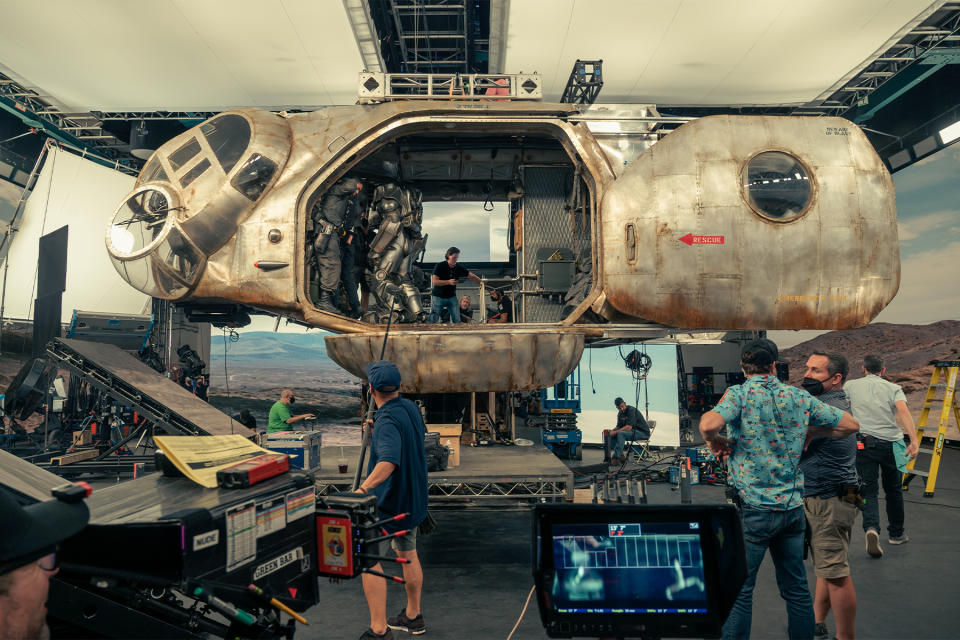
The Volume is a type of soundstage that recently gained popularity for its use on big budget productions like The Mandalorian, wherein the set can be fully surrounded by massive LED panels. Utilizing the Unreal Engine, a graphical development tool typically used to create video games, it acts as a three-dimensional backdrop for filming, but unlike green screens or matte painting, it functions as fully realized space, not just adjusting perspective realistically as you walk by, but providing a sense of “natural” lighting resembling that of on-location shooting.
It’s an ideal technology for production like Fallout, where expansive worldbuilding happens in the periphery. The only problem is that there was no Volume in New York. As explained by Cummings, Nolan actually had to have a Volume set built specifically for shooting Fallout – one custom made with a different shape and scale that would, “Allow [him] to do the sets in a different way that they can’t do on other Volumes.”
On the set of the Volume on Long Island, you can see how bleeding edge technology could be used to compliment the practical production. Here are ruins of the Griffith Observatory, its dome in tatters as rubble and bullets roll across the ground. Everything is on fire – literally – as pyrotechnic teams stoke controlled flames from the aftermath of whatever brutality had occurred. There’s a giant cage resting ominously in the center of the room.
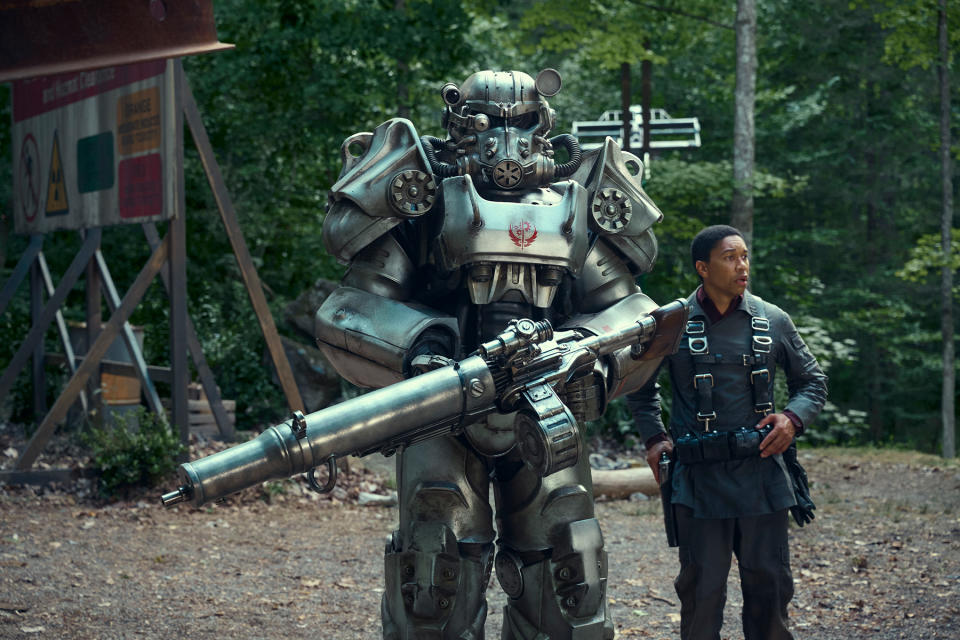
But beyond it all, within the LED curvature of the Volume’s screens lies the remains of Los Angeles, crumbled and sad in its silhouette. It’s dusk indoors, as the screens generate an eerily realistic skyscape. The experience is unsettling. Like a haunted painting, its gaze follows wherever you go as the parallax effect of its projection shifts perspective depending on where you look.
Off to the side, there’s a row of director’s chairs for the bulk of the main cast, including Purnell, Aaron Moten, and Kyle MacLachlan, who plays Lucy’s father and the Overseer of Vault 33. Shippey, the lead stunt performer fully clad in Brotherhood of Steel armor, is suspended in the giant rig that allows him to “sit,” taking a load off like an unthinkably large action figure positioned on display.
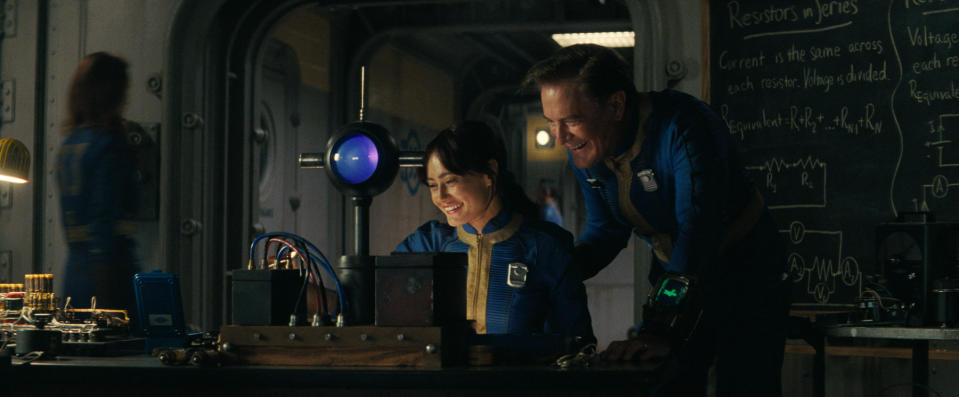
If being on the set of Filly felt like a nightmarish twist on Disneyland, the Volume set is more like being on the rides. Unlike behind-the-scenes footage seen from other shows, where a single prop or minimalist set is created for the volume to build around, the approach taken by the production here is much closer to the filmmaking of old. Almost everything is practical, something to be touched or picked up, but the LED screens wrapped around serve to extend what’s already there — projecting the outer dome of the observatory and the mental trickery of the entire city of Los Angeles laid out before you.
For Nolan, this was all top of mind. He’s fully aware that simply by making Fallout into a TV show, the fans will already have lost something that makes the games great: the fact that they’re games.
“It’s hard not to imagine, in some ways, it’s kind of a step backwards,” he says. “But it’s really just a different way of experiencing the story. The challenge for us is how do you make it feel like the audience [has] explored that environment? [That] they poked their head into the bathroom and looked at it without actually having that control? The answer was, ‘You hire the most talented people in the business, you think really about the grammar of your shots, and make sure you’re nice and wide and capturing the environments, [using] all the right tools and then altogether, it [feels] like reality.’”
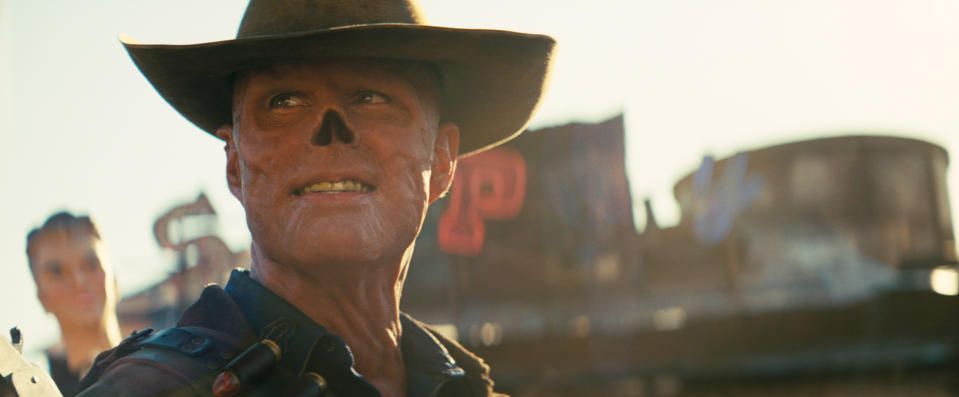
Before long, the sounds of clanging spurs interject the scene as Goggins, in full makeup as The Ghoul, strides to the middle of set, black duster trailing in tow. Filming is about to resume, and handed a preview monitor, I crouch back-to-the-wall with the set as the scene plays out. Gunfire rattles and dramatics ensue, but what transpires is for viewers to find out for themselves.
Time will tell whether the final product registers with audiences, both fans and newcomers alike. In conversation, both Nolan and co-showrunner Graham Wagner point toward the success of HBO’s The Last of Us as the kind of show that managed to bring video game storytelling to the masses by, in Nolan’s words, “Taking it fucking seriously.” Based on everything we’ve seen, the cast and crew of Fallout are taking this pretty fucking seriously. At the very least, they may have created the most authentic video game adaptation yet.
Best of Rolling Stone

